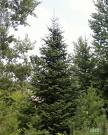Blister Fir Tree Information
Images of Blister Fir:






Blister Fir grows in the following 20 states and provinces:
Alberta, Connecticut, Iowa, Maine, Manitoba, Massachusetts, Michigan, Minnesota, New Brunswick, New Hampshire, New York, Nova Scotia, Ontario, Pennsylvania, Prince Edward Island, Saskatchewan, Vermont, Virginia, West Virginia, WisconsinInformation about Blister Fir:
The Abies Balsamea is commonly known as the Balsam, Balsam Fir, Blister Fir, Bracted Balsam Fir, Canada Balsam, Canadian Balsam as well as Eastern Fir.
The currently accepted scientific name of balsam fir is Abies balsamea (L.) Mill . The genus Abies consists of about 40 species of evergreen trees found in the Northern Hemisphere. Nine Abies species, including balsam fir, are native to the United States. Balsam fir is widely distributed and exhibits geographic variation. Two varieties based on morphological differences are recognized : var. balsamea var. phanerolepis Fern. Balsam fir is closely related to Fraser fir (A. fraseri). These species are probably relicts of an ancestral taxon which exhibited north-south clinal variation . Trees in Virginia and West Virginia are possibly hybrids between these two species . Some authorities recognize Fraser fir as a variety of balsam fir: A. b. var. fraseri . Balsam fir hybridizes with subalpine fir (A. lasiocarpa) where their ranges overlap in the Canadian Rockies .Balsam fir is widely distributed in northeastern North America. It occurs from Newfoundland west across northern Quebec, northern Ontario, central Manitoba, and Saskatchewan to northwestern Alberta, south about 400 miles (640 km) to central Alberta, southeast to northern Minnesota and Wisconsin, and east to New England . In the United States, scattered populations occur in southern Minnesota, southern Wisconsin, northeastern Iowa, Pennsylvania, West Virginia, and northern Virginia. The two varieties are distributed as follows : var. balsamea - from Newfoundland and Labrador west to northeastern Alberta and south to Minnesota, Wisconsin, southern Ontario, northern Pennsylvania, New York, and New England. It is local in northeastern Iowa. var. phanerolepis - from Newfoundland and Labrador to Ontario and Maine and in the high mountains of New Hamphire, Vermont, and New York. It is also common in the higher mountains of Virginia and West Virginia.Balsam fir is more commonly found in mixed than in pure stands. It does occurs as a dominant species in pure stands in Newfoundland, Ontario, and Quebec. Its importance as a major forest tree declines west of Manitoba . Balsam fir is a principal tree of boreal mixed stands in Canada, where it occurs with paper birch (Betula papyrifera), aspen (Populus tremuloides), black spruce (Picea mariana), and white spruce (P. glauca) . In the Lake States, climax stands of balsam fir are relatively uncommon . In Maine, balsam fir forms pure stands on flats between swamps and uplands . In the Adirondacks, balsam fir sometimes dominates upper slopes above 3,200 feet (975 m) . In New England and the Lake States, balsam fir is more commonly found in mixed stands, especially in forests dominated by black spruce, red spruce (Picea rubens), white spruce, eastern hemlock (Tsuga canadensis), northern white-cedar (Thuja occidentalis), paper birch, aspen, and red maple (Acer rubrum) . Balsam fir is listed as a dominant part of the vegetation in the following community type (cts) and ecosystem (eas) classifications: Area Classification Authority PQ: Gaspe Peninsula forest veg. cts Zoladeski 1988 ON forest eas Jones & others 1983Some of the information provided here is attributed to:Uchytil, Ronald J. 1991. Abies balsamea. In: Fire Effects Information System, [Online]. U.S. Department of Agriculture, Forest Service, Rocky Mountain Research Station, Fire Sciences Laboratory (Producer). , available at the USDA Fire Effects Information System (FEIS) website